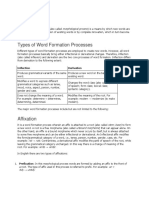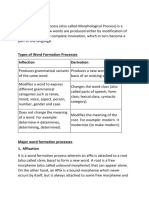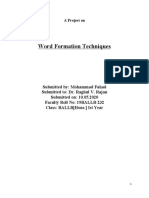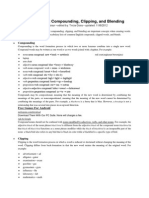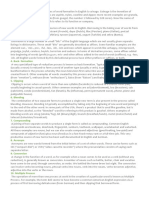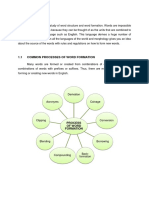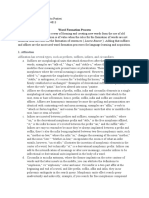0 ratings0% found this document useful (0 votes)
68 viewsBab II Morphology
The document discusses various morphological processes in language, which are ways that words can be formed or modified. It defines morphological process as the combination of morphemes, the smallest units of meaning, to form words. There are two main types of morphological processes: concatenative, which involve combining morphemes linearly like affixation, and non-concatenative, which alter morphemes internally like reduplication. Some common concatenative processes discussed are affixation, compounding, and incorporation. Non-concatenative processes include reduplication, internal modification, and conversion between word classes.
Uploaded by
madanfalah11Copyright
© © All Rights Reserved
Available Formats
Download as DOCX, PDF, TXT or read online on Scribd
0 ratings0% found this document useful (0 votes)
68 viewsBab II Morphology
The document discusses various morphological processes in language, which are ways that words can be formed or modified. It defines morphological process as the combination of morphemes, the smallest units of meaning, to form words. There are two main types of morphological processes: concatenative, which involve combining morphemes linearly like affixation, and non-concatenative, which alter morphemes internally like reduplication. Some common concatenative processes discussed are affixation, compounding, and incorporation. Non-concatenative processes include reduplication, internal modification, and conversion between word classes.
Uploaded by
madanfalah11Copyright
© © All Rights Reserved
Available Formats
Download as DOCX, PDF, TXT or read online on Scribd
You are on page 1/ 5
BAB II
DISCUSSION
A. Definition of Morphological Process
Morphological process is the process in which the language user combines one
morpheme with another in order to form a word. Hnece, moprheme plays a role as the
smallest elements in the srtucture of the word. Morphological process is a process
combining two morphemes in finding new word. They may change the word’s
meaning (derivational) or its grammatical functions (inflectional).
There are several different types of processes, not all of which are present in all
languages. Some of these are concatenative, meaning that they invole the linear
combination of morphemes (affixation, for example), while others are non-
concatenative, involving the internal alternation of morphemes.
B. Types and Process of Morphological Process
The tpes of morphological process are divided into two Concatenative and non-
Concatenative.
1. Concatenative :
a. Affixation
Affixation is the addition of affixes, affixation occurs when there is a
morpheme attached to a root or word root. There are several type of
affixation is prefix, suffix. An affix is a word element of English
grammar used to alter the meaning or form of a word and comes in the
form of either a prefix or a suffix. Prefixes include examples like
"un-," "self-," and "re-," while suffixes come in the form of ending
elements like "-hood," "-ing," or "-ed."
b. Compounding
Compounding can be used to form new words through combining two
stems as in the words blackbird or housekeeper. Compounds can be
composed of many parts of speech. Some examples include:
1) noun-noun such as horseshoe
2) noun-verb such as trouble-shoot
3) adjective-verb or high-jump
4) adjective-adjective such as bittersweet
5) adjective-noun such as jumping bean
6) verb-noun such as spelling bee
7) verb-preposition such as push-up
8) preposition-verb such as out-cast
c. Incorporation
Similar to compounding, typically as noun-incorporation where a
nominal stem is fused with a verbal stem to yield a larger, derived
verbal stem.
2. Non-Concatenative:
a. Reduplication
b. Internal modication
c. Conversion
Conversion involves the change of a word from one grammatical
category to another without any overt morphological change.
Essentially, a word is "converted" from one part of speech to another,
such as a noun becoming a verb or a verb becoming a noun, without
the addition of affixes. Example :
1) Noun to verb
- He will chair the meeting (noun : chair)
- She will paper the walls (noun : paper)
2) Verb to noun
- His swim as impressive (verb : swim)
- I enjoy a good read (verb : read)
3) Adjective to noun
- The poor need our help (adjective : poor)
- The elderly should be respected (adjective : elderly)
4) Noun to adjective
- She wore a diamond ring. (noun: diamond)
- They live in a beach house. (noun: beach)
d. Borrowing
That language has not term in the language itself or it can be said that
one of the most common source s of new words in English is process
simply labeled borrowing, that is taking over of words from other
languages.
For example: bamboo (Chinese), alcohol(Arabic), piano(Italia),yogurt
(Turkish), boss (Dutch),zebra (Bantu),robot (chezch), tycoon
(Japanese),lilac(Persian), croissant(French)
e. Coinage
Coinage is a morphological process in which new words are created by
inventing completely new forms. It involves the creation of a word
without relying on existing morphemes or borrowing from other
languages. Coinage is often used to name new concepts, inventions, or
brands.
The process of coinage typically involves creating a word based on
sound symbolism, arbitrary combinations of letters, or by blending
existing words. Here are a few examples of coinage:
1) Kodak: This brand name was coined by George Eastman for his
company that produced photographic equipment. It is believed
to have been chosen for its distinctive sound and ease of
pronunciation.
2) Xerox: The term "xerox" was coined by the Xerox Corporation
as a brand name for their photocopying machines. The word
has become synonymous with making photocopies, even
though it was initially a brand name.
3) Frappuccino: This is a blended word created by Starbucks to
name their blended coffee beverage. It combines "frappe" (a
term used for a blended beverage) with "cappuccino" (a type of
coffee).
4) Google: The term "Google" was coined by Larry Page and
Sergey Brin, the founders of the internet search engine. It is
derived from the mathematical term "googol," which refers to
the number 1 followed by 100 zeros, representing the vast
amount of information Google aims to organize and make
accessible.
f. Clipping
Clipping: to cut/to clip the initial part of the word comes gather the
final part. Clipping is a common word formation process in English
and is often used to create informal or colloquial words. There are
several types of clipping:
1) Back-clipping: This occurs when the beginning of a word is
removed, and the resulting shortened form retains the final
portion. For example:
- Advertisement → Ad
- Laboratory → Lab
2) Fore-clipping: This happens when the end of a word is
removed, and the remaining portion becomes the clipped form.
For example:
- Refrigerator → Fridge
- Mathematics → Math
3) Middle-clipping: This involves removing a portion from the
middle of a word, typically leaving the beginning and end
intact. Middle-clipping is less common than back-clipping and
fore-clipping, but still occurs in some cases. For example:
- Hamburger → Burger
- Television → TV
g. Blending
h. Acronym
i. Backformation
Backformation is the formation of a word from one that looks like
its derivative. It is usually derived from verbs. Backformation is a
morphological process in linguistics where a new word is formed
by removing what appears to be an affix from an existing word. It
involves the creation of a new word by subtracting a supposed
affix, which is often incorrectly perceived as part of the original
word's morphology. In backformation, a word is mistakenly
analyzed as having a derivational affix, when in fact the perceived
affix is a result of historical or etymological processes rather than a
productive morphological rule. This misanalysis leads to the
creation of a new word through the removal of the presumed affix.
Here's an example to illustrate the process of backformation:
Original word: Donation
Perceived affix: -ation (suffix)
Backformed word: Donate
In this example, the word "donate" is formed by backformation
from the word "donation." Speakers of English may perceive "-
ation" as a derivational suffix indicating a noun, leading them to
create a new verb "donate" by removing the supposed suffix.
Backformation often occurs when speakers perceive a word as
being derived from another word with a recognizable affix.
However, the perceived affix may actually be a part of the word's
historical development rather than a productive morphological rule.
Nonetheless, backformation is a common process in language
change and has contributed to the creation of many words in the
English language.
j. Multiple Process
In the context of morphological processes, "multiple processes"
refers to the existence of multiple mechanisms or strategies that can
be employed in word formation. It means that there isn't just one
single process at work, but rather a range of processes that can be
utilized to create new words or modify existing ones. In other
words, multiple process is combination two processes in creation of
a particular word. The presence of multiple processes in
morphological processes allows for rich and diverse word
formation in languages, enabling speakers to create new words,
modify existing ones, and express complex ideas. For example: the
term deli visa process ‘borrowing’ delicatessen (German) and then
‘clipping’ that borrowed form.
You might also like
- 5.3 - Morphology - Morphological ProcessesNo ratings yet5.3 - Morphology - Morphological Processes4 pages
- Fariz Fadillah Akbar - 190511100086 - Final Test LexicographyNo ratings yetFariz Fadillah Akbar - 190511100086 - Final Test Lexicography7 pages
- Benghazi University Spring 2022 Morphology Third Presentation-1No ratings yetBenghazi University Spring 2022 Morphology Third Presentation-130 pages
- Nadya Yasmine Dita Pratiwi - 2100004013 - Word Formation ProcessNo ratings yetNadya Yasmine Dita Pratiwi - 2100004013 - Word Formation Process3 pages
- Word Formation Processes: Second, New Words Can Enter A Language Through TheNo ratings yetWord Formation Processes: Second, New Words Can Enter A Language Through The11 pages
- Processes of Word Formation I DefinitionNo ratings yetProcesses of Word Formation I Definition19 pages
- Formation: The Study of Language George YuleNo ratings yetFormation: The Study of Language George Yule22 pages
- Morphological Productivity 230727 120946No ratings yetMorphological Productivity 230727 1209469 pages
- The Main Goal of The Research Is To Study The Processes of Creating New Lexemes, FeaturesNo ratings yetThe Main Goal of The Research Is To Study The Processes of Creating New Lexemes, Features13 pages
- On the Evolution of Language First Annual Report of the Bureau of Ethnology to the Secretary of the Smithsonian Institution, 1879-80, Government Printing Office, Washington, 1881, pages 1-16From EverandOn the Evolution of Language First Annual Report of the Bureau of Ethnology to the Secretary of the Smithsonian Institution, 1879-80, Government Printing Office, Washington, 1881, pages 1-16No ratings yet
- Compound Words Typographic Technical Series for Apprentices #36From EverandCompound Words Typographic Technical Series for Apprentices #364/5 (1)
